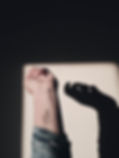Aftercare
Healing Timeline
Most tattoos take about 2 weeks to heal on the surface. This can vary slightly depending on the size, placement, and style of the tattoo.
-
Fine line tattoos often heal quicker.
-
Heavily saturated or color-rich tattoos may take a little longer.
Listen to your body—some people heal faster or slower than others.
How to Wash Your Tattoo
Your first wash should happen right after removing your bandage.
-
Wash your hands first.
-
Clean the tattoo 1–3 times daily, depending on activity and exposure.
-
Use a gentle antibacterial soap like Dial Gold, Dove Unscented, or Dr. Bronner’s.
-
Lather the soap in your hands, not directly on the tattoo. Gently wash the area for about a minute.
-
Rinse thoroughly and let it air dry.
-
Avoid towels—they can harbor bacteria.
-
If needed, pat dry gently with a clean paper towel.
-
Moisturizing
Lotion doesn’t heal your tattoo—your body does. Lotion is simply for comfort and to prevent excessive dryness.
-
You can wait up to 3–4 days to start moisturizing, or begin earlier if your skin feels tight or dry.
-
Apply fragrance-free lotion 1–3 times a day in a very thin layer—your tattoo shouldn’t look shiny or greasy.
-
Recommended: Cetaphil, Lubriderm, or pure coconut oil.
-
Avoid petroleum-based products like Aquaphor unless used in moderation and only for highly saturated pieces. These can trap moisture and prevent proper airflow.
What to Avoid During Healing
-
Submerging your tattoo: No swimming, baths, hot tubs, or saunas until fully healed. These increase the risk of infection and fading.
-
Sun exposure: Keep your tattoo out of direct sunlight. Do not apply sunscreen during healing—cover with loose clothing. Once healed, sunscreen is a must to prevent fading.
-
Re-bandaging: Unless advised by your artist, there’s no need to re-wrap. Improper bandaging can trap bacteria and cause irritation.
-
Heavily scented soaps or lotions: Fragrances can cause allergic reactions, delay healing and often contain alcohol.
-
Scratching or picking: Itching is normal. Try gently slapping the area or scratching nearby—but never pick at scabs or flakes.
-
Tight clothing: Friction can damage the healing skin, rub off scabs, and in rare cases cause a pressure blowout.
Still Have Questions?
Everyone’s healing journey is a little different. If you’re unsure about anything or notice signs of infection (excessive redness, swelling, pus, or a fever), reach out to your tattoo artist or a medical professional right away.

Before Your Appointment
Preparing for your tattoo appointment is crucial. Make sure to eat a good meal beforehand and stay hydrated. Avoid alcohol and aspirin as they can thin your blood. Get a good night's sleep to ensure your body is ready for the experience.
During the Session
During your tattoo session, relax and communicate openly with your artist. If you feel uncomfortable or need a break, don't hesitate to speak up. Remember to breathe and stay calm. Trust the process and let the artist work their magic.


Aftercare Tips
Proper aftercare is essential for the best tattoo healing. Keep the tattoo clean and moisturized. Follow the artist's instructions for washing and applying ointment. Avoid exposing the tattoo to direct sunlight and soaking in water until it's fully healed.
